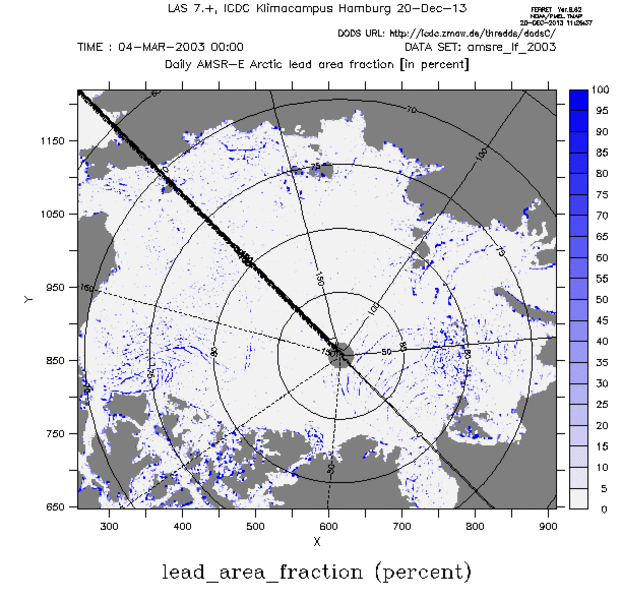Lead Area Fraction for Arctic from AMSR-E Data

Topics
- Access
- Description
- Parameters
- Coverage, spatial and temporal resolution
- Data quality
- Contact person
- References
- Data citation
Access
UNRESTRICTED:
RESTRICTED:This link to the data set is only available for a restricted user group. The data set is only accessible in CEN/MPI net or accessible from external nets with a customer account. Please contact ICDC if you would like to access this data from outside the network.
- Data access via file system: /data/icdc/ice_and_snow/arctic_lead_fraction_amsre
Description
Advanced Microwave Scanning Radiometer aboard EOS (AMSR-E) data are used to produce a data set of the lead area fraction for Arctic sea ice for the freezing season (November - April) on the NSIDC polar-stereographic grid with 6.25 km grid resolution.
For this purpose AMSR-E brightness temperatures observed at 19 GHz and 89 GHz (TB19 and TB89) are interpolated onto the 6.25 km NSIDC polar-stereographic grid. From these the ratio r = TB89/TB19 is computed. This ratio takes considerably larger values over leads and thin ice than over the adjacent thicker sea ice. By moving a 7x7 grid cell search window over maps of r, grid cells are identified which exhibit a substantially larger r than the background value; the latter is computed as Median(r) and subsequently the difference between actual (the center grid cell of the 7x7 window) and the background is computed: r' = r - Median(r). By using coincident MODIS visible imagery tie points are selected which permit to translate r' into the lead ice concentration or lead area fraction which is computed for every grid cell. More details about the approach can be found in Roehrs and Kaleschke (2012) and Roehrs et al. (2012) (see References).
This data set is a CliSAP/KlimaCampus Product.
Last update of data set at ICDC: December 19, 2013
Parameters
| Name | Range |
|---|---|
| Lead Area Fraction | 0-100% |
| Status Flag | 0, 1, 100, 110, 120 |
Coverage, spatial and temporal resolution
Period and temporal resolution:
- November 1, 2002, to April 30, 2011
- Daily for freezing season: November 1 to April 30
Coverage and spatial resolution:
- Northern hemisphere
- Spatial resolution: 6.25 km x 6.25 km, polar-stereographic grid from NSIDC, tangential plane at 70°N and 70°S, respectively
- Geographic longitude: -180°E to 180°E
- Geographic latitude: from about 41°N to 90°N, in the corners of the grid further equatorward
- Dimension: 1216 columns x 1792 rows
- Altitude: 0.0 m
Format:
- NetCDF
Data quality
The data set does not yet contain uncertainty estimates.
A number of comparisons with independent data (Envisat ASAR, MODIS, Cryosat-2) has been carried out. These show that about 50% of the leads present in MODIS imagery (500 m grid resolution) can be identified with the approach used here (6.25 km grid resolution). The minimum width down to which leads can be identified is about 3 km. Note that the leads need to be dominantly covered by thin ice; if too much open water is present the approach provides a less reliable result.
Because of the size of the searching window the approach cannot generally applied to identify larger thin ice areas or polynyas.
More details are found in the references.
Contact
Lars Kaleschke
Alfred Wegener Institut für Polar- und Meeresforschung / Bremerhaven
E-Mail: lars.kaleschke (at) awi.deStefan Kern
ICDC / CEN / Universität Hamburg
E-Mail: stefan.kern@uni-hamburg.d(stefan.kern"AT"uni-hamburg.de)e(annika.jahnke-bornemann"AT"uni-hamburg.de)
References
Literature:
- Röhrs, J. and Kaleschke, L.: An algorithm to detect sea ice leads by using AMSR-E passive microwave imagery, The Cryosphere, 6, 343-352, doi:10.5194/tc-6-343-2012, 2012.
- Röhrs, J., Kaleschke, L., Bröhan, D., and Siligam, P. K.: Corrigendum to "An algorithm to detect sea ice leads by using AMSR-E passive microwave imagery", The Cryosphere, 6, 343–352, 2012, doi:10.5194/tc-6-365-2012
Data citation
Please cite the data as follows:
"AMSR-E Arctic lead area fraction, [PERIOD], Integrated Climate Data Center (ICDC), CEN, University of Hamburg, Hamburg, Germany, [Month, Year]".
und die beiden Leitartikel Roehrs and Kaleschke (2012) und Roehrs et al. (2012) zitieren.
and with the following acknowledgments:
Thanks to ICDC, CEN, University of Hamburg for data support.
